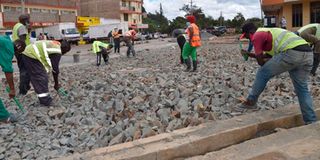Construction the silver lining, with 60,000 new jobs

Workers at a road construction site in Nyahururu town in this picture taken on April 24, 2021.
Increased investment in construction, as Covid-19 ravaged the country, saved a portion of the economy last year, creating thousands of new job opportunities as other sectors suffered.
The construction, which ranged from roads, railway lines and houses, provided a lifeline to over 60,000 Kenyans, as many shifted to building works to earn a living.
The Economic Survey 2021 reports that wage employment in the construction sector grew by 33 per cent from 173,300 persons in 2019 to 230,500 persons in 2020.
“Employment level in the public sector rose by 3 per cent from 8,832 persons in 2019 to 9,093 persons in 2020, while private sector employment recorded 34.5 per cent increase from 164,500 persons in 2019 to 221,400 persons in 2020,” the report states.
This came even as the housing sector recorded improved activity, where The State Department for Housing and the National Housing Corporation completed 2,670 units of public residential buildings, with the value of completed public buildings increasing from Sh1.5 billion in 2019 to Sh9 billion. The value of completed private buildings in Nairobi City County also increased by 6.4 per cent from Sh94 billion in 2019 to Sh100 billion in 2020.
The construction sector registered a total growth of 11.8 per cent in 2020 compared to 5.6 per cent in 2019. The sector captured infrastructural investment in roads, railway, ports, housing and other sectors.
“Cement consumption, a key input to construction activities rose significantly from 6.1 million tonnes in 2019 to 7.4 million tonnes in 2020, representing an increase of 21.3 per cent,” the report observed.
Among the key infrastructural projects that were ongoing last year is the ongoing construction of the Nairobi Expressway, which is a 108-kilometre lane-length road, with a construction cost of Sh63.8 billion. The road was 16.6 per cent complete as at December 31, 2020.
The construction of a 2.1 kilometres floating bridge across the Likoni Channel was also completed at a cost of Sh2 billion, while the Kibwezi–Kitui–Migwani road was at 73 percent completion as at December 31, 2020.
The report shows that by June last year, the total length of paved (under bitumen) roads was 22.6 thousand kilometres, an increase of 1.8 per cent from 22.2 thousand kilometres in June 2019.
The government, however, cut the budget for roads by 18.5 per cent, from Sh207.2 billion in 2019/20 to Sh168.9 billion in 2020/21.
“Loans and advances from commercial banks to the construction sector grew by 3.4 per cent from Sh115.8 billion in 2019 to Sh119.7 billion in 2020,” the survey reported. Increase in credit to a sector indicates that creditors have confidence due to the ongoing economic activities around it.
“Overall, a total of Sh168 billion is expected to be utilised on road works in progress covering a total distance of 5,997.3 kilometres. A total of Sh4.2 billion is expected to be used to build 7.72 kilometres of bridges, while Sh144.1 billion is earmarked for the construction and improvement of 3,625.4 kilometres of roads. A total of Sh7.5 billion is expected to be used to build 279.4 kilometres of dualling,” the report added.
As the construction sector glowed in the middle of a pandemic, the transport sector, on the other hand, suffered, following the government’s containment measures that saw many public transport vehicles grounded, as people stayed home.
The report showed that the value of output from the transport and storage sector declined by 5.2 per cent to Sh1.97 trillion in 2020, a reversal from the 10.7 per cent growth (to Sh2.08 trillion) registered in 2019.
Road and Railway increased by 1 per cent in terms of value of output, from Sh1.53 trillion in 2019 to Sh1.54 trillion last year. The sub-sector accounted for 78.4 per cent of total output in 2020, as other modes of transport suffered huge blows.
“Similarly, output from pipeline transport, railway transport and water transport sub sectors declined by 16.3 per cent, 15.3 per cent and 4.3 per cent to Sh26.7 billion, Sh12.6 billion and Sh52.5 billion, respectively, during the same period. Output from postal and courier services sub-sector also reduced by 10.7 per cent to Sh18.7 billion during the review period,” the report stated.
In the railway sub-sector, the volume of cargo transported through the Meter Gauge Railway (MGR) dropped by 5.8 per cent from 667,000 tonnes in 2019 to 628,000 tonnes in 2020, while revenue from the operations rose by 15.7 per cent from Sh963 million in 2019 to Sh1.114 billion in 2020.
“The number of passengers transported through MGR declined by more than half from four million in 2019 to 1.9 million in 2020. The decrease in number of passengers is largely attributed to restrictions of movement by the government to combat the spread of Covid-19. Consequently, revenue from MGR passenger stream declined by half from Sh167 million in 2019 to Sh82 million in 2020,” the survey stated.
For the Standard Gauge Railway (SGR), the volume of freight transported increased by 4.8 percent from 4.2 million tonnes in 2019 to 4.4 million tonnes in 2020, while revenue realised reduced by 19.6 per cent from Sh13 billion in 2019 to Sh10.46 billion in 2020.
“The number of passengers handled through the SGR declined by 49.2 per cent to 812,000 in 2020. This decline was largely attributed to the suspension of SGR passenger rail services from April to May 2020 due to measures instituted by the government to curb the spread of Covid-19.
"The reduction in passenger numbers resulted in a sharp decline in revenue, which dropped by 47.8 per cent from Sh1.717 billion in 2019 to Sh896 million in 2020.”





